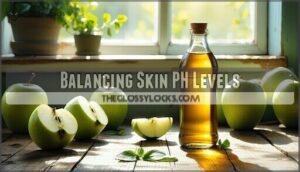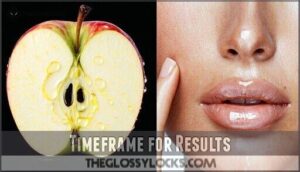This site is supported by our readers. We may earn a commission, at no cost to you, if you purchase through links.

The natural acids help break down melanin deposits that create those pesky brown patches. Always dilute the vinegar to prevent skin irritation, and test a small area first.
Apply sunscreen religiously since acids increase sun sensitivity. Results typically appear after 4-6 weeks of consistent use.
While this pantry staple won’t work miracles overnight, it’s gentler than harsh chemicals and costs pennies compared to professional treatments. The secret lies in understanding proper application techniques and timing expectations.
Table Of Contents
- Key Takeaways
- How to Treat Age Spots With Apple Cider Vinegar?
- How to Apply Apple Cider Vinegar for Age Spots
- Benefits of Apple Cider Vinegar for Age Spots
- Precautions and Considerations
- Timeframe for Results
- Professional Treatment Options
- Frequently Asked Questions (FAQs)
- Does apple cider vinegar lighten age spots?
- How to get rid of age spots naturally?
- Does apple cider vinegar help dark spots?
- Can lemon juice lighten age spots?
- Can aloe vera help fade age spots?
- How to use apple cider vinegar for aging skin?
- Will apple cider vinegar fade age spots?
- Can you apply apple cider vinegar directly to skin?
- What dissolves age spots?
- Is organic apple cider vinegar more effective for treatment?
- Conclusion
Key Takeaways
- Always dilute apple cider vinegar with water – Mix one part ACV with two parts water to prevent skin irritation and chemical burns, then apply with a cotton ball directly to age spots twice daily.
- Start slow and test first – Perform a patch test on a small skin area and begin with once-daily applications, gradually increasing frequency as your skin builds tolerance.
- Protect your skin from sun exposure – Apply broad-spectrum sunscreen religiously since ACV increases UV sensitivity, and avoid peak sun hours between 10 AM and 4 PM.
- Be patient with realistic expectations – You’ll see initial changes within 2-4 weeks, but significant fading typically takes 6-8 weeks of consistent daily use.
How to Treat Age Spots With Apple Cider Vinegar?
Treating age spots with apple cider vinegar starts with proper dilution. Mix one part ACV for age spots with two parts water to prevent skin irritation. Apply this solution to dark spots using a cotton ball, allowing it to air dry completely.
Apple cider vinegar’s gentle acids naturally fade age spots when diluted properly and applied consistently over time.
Start with once-daily applications to gauge your skin’s tolerance. The natural acids in apple cider vinegar work to fade age spots by gently exfoliating dead skin cells and reducing melanin production.
ACV Application Frequency can increase to twice daily as your skin adapts. Always perform a patch test first to avoid ACV Side Effects like redness or burning.
Consistency matters most when you treat age spots naturally. Turmeric can also help, thanks to its melanin regulation properties.
Results typically appear after several weeks of regular use, though Spot Recurrence may happen without continued sun protection.
How to Apply Apple Cider Vinegar for Age Spots
Understanding how to treat age spots starts with proper application technique. Start by choosing raw, organic apple cider vinegar and create the right dilution – mix one part ACV with two to three parts water. This ACV concentrations approach prevents skin irritation while maintaining effectiveness.
You can also find specialized ACV products designed for this purpose. Clean your face gently, then apply the solution to age spots using a cotton ball. You can either rinse or leave the solution on your skin – leaving it on provides better results for most people.
Begin with once-daily application frequency, gradually increasing to twice daily as your skin adapts. Here’s your step-by-step approach:
- Spot treatment: Dab solution directly onto age spots with cotton ball
- Timing: Start once daily, increase frequency based on tolerance
- Sensitive skin: Further dilute solution and monitor reactions closely
Watch for redness or irritation – these signs mean you should reduce frequency or increase dilution. Consistency matters more than intensity when using ACV for age spots. Apply moisturizer and sunscreen afterward to protect your skin during this natural healing process.
Benefits of Apple Cider Vinegar for Age Spots
Apple cider vinegar offers several potential benefits for treating age spots through its natural acids and skin-balancing properties.
You’ll find that ACV contains alpha-hydroxy acids that may help lighten pigmentation while gently exfoliating your skin to promote cell turnover, which can lead to a more even skin tone and reduced appearance of age spots with natural acids.
Natural Skin Lightening Agent
Apple cider vinegar’s ACV properties make it a powerful home remedy for skin lightening.
Apple cider vinegar’s natural acids gently lighten age spots while balancing your skin’s pH for healthier, more even-toned complexion.
The acetic acid naturally inhibits melanin reduction by breaking down existing pigment clusters in your age spots. This natural astringent creates gentle exfoliation while balancing your skin’s pH levels.
Some users explore ACV skin lightening products to enhance their routine.
ACV skin benefits for treating age spots include:
- Natural remedies that cost less than commercial treatments
- Alpha-hydroxy acids that promote cell turnover
- Antioxidants fighting free radical damage
- Malic acid reducing excess melanin production
Exfoliating Dead Skin Cells
Your skin naturally sheds dead cells, but sometimes they stick around longer than welcome.
Apple cider vinegar’s alpha hydroxy acids promote gentle exfoliation, encouraging healthy cell turnover without harsh scrubbing.
This natural skin exfoliation process smooths skin texture and removes the dull layer that makes age spots more noticeable.
Better yet, removing dead skin cells improves product absorption, making your other skincare treatments work more effectively.
It’s like giving your skin a fresh start.
Balancing Skin PH Levels
Maintaining your skin’s natural acidity becomes essential when tackling age spots.
Apple cider vinegar’s acetic acid content helps restore ideal skin pH levels, typically around 4.5-5.5.
This balanced environment strengthens your healthy skin barrier while reducing bacteria that worsen pigmentation.
- pH imbalance effects include increased sensitivity and slower healing
- ACV’s pH impact creates an inhospitable environment for harmful microorganisms
- Maintaining acidity supports natural skin regeneration across all skin types
Precautions and Considerations
While apple cider vinegar offers potential benefits for age spots, you must take specific precautions to protect your skin from irritation and damage.
Always dilute ACV properly, test it on a small skin area first, and use sunscreen daily since ACV can increase your skin’s sensitivity to UV rays.
Skin Sensitivity Test
Testing your skin’s reaction is like checking the water temperature before diving in—it prevents an unpleasant surprise.
Before applying apple cider vinegar to age spots, conduct a patch test to identify potential skin sensitivity issues.
Apply a small amount of diluted solution to a hidden area, like your inner wrist. Wait 24 hours and watch for redness indicators, itchiness evaluation, or other irritation signs.
If you notice any allergy concerns like burning or swelling, don’t proceed—the mixture could irritate your sensitive skin further.
Even natural remedies can trigger an allergic reaction, so this precautionary step protects you from unnecessary discomfort.
Dilution Ratio Importance
Getting the dilution right when you treat age spots with apple cider vinegar isn’t rocket science, but it’s the difference between healthy skin and a chemical burn.
The acetic acid in undiluted ACV can wreak havoc on your skin’s pH balance, causing serious irritation prevention issues.
Here’s your roadmap for application safety:
- Start with 1:2 ratio (one part ACV to two parts water)
- Test on a small patch first for sensitivity concerns
- Adjust water ratio up if stinging occurs
- Never apply undiluted ACV directly to skin
- Monitor for redness or burning sensations
These ideal ratios protect against long-term effects while maximizing benefits.
Sun Protection Necessity
After properly diluting your apple cider vinegar, you’ll need robust sun protection.
ACV increases UV sensitivity, making your skin vulnerable to cumulative damage.
Apply broad-spectrum sunscreen daily when using this treatment.
For maximum defense, consider broad-spectrum sunscreen options.
Avoid peak hours between 10 AM and 4 PM, and wear protective clothing.
Without proper sunscreen efficacy, you risk worsening existing age spots rather than treating them effectively.
Timeframe for Results
How long does it take for apple cider vinegar to fade age spots? Patience becomes your greatest ally when using this home remedy for hyperpigmentation treatment.
Natural solutions don’t deliver overnight miracles, but consistent application yields gradual results.
Here’s the realistic ACV timeline you can expect:
- Initial changes: Mild improvement may appear within 2-4 weeks of daily use
- Noticeable fading: Significant lightening typically occurs after 6-8 weeks of regular treatment
Individual variance affects how quickly you’ll see expected changes. For faster results, consider Cryopen cryotherapy, a popular method for addressing skin imperfections.
Some people notice results sooner, while others need 3-6 months for desired outcomes. Setting realistic expectations helps you stay committed to your apple cider vinegar routine.
Professional Treatment Options
Apple cider vinegar works well, but sometimes you’ll need stronger options for persistent spots.
Laser treatments and IPL photofacials target melanin directly, breaking down pigmentation faster than home remedies. Chemical peels remove damaged skin layers, while microdermabrasion and dermabrasion physically exfoliate deeper than topical solutions.
Dermatologists can prescribe prescription creams containing hydroquinone, which bleaches spots more effectively than natural alternatives. Cryotherapy freezes age spots off completely. Laser resurfacing resurfaces entire areas for thorough improvement.
These treatments like radio frequency microneedling boost collagen production.
These professional treatments cost more but deliver quicker, more dramatic results when natural methods aren’t cutting it.
Frequently Asked Questions (FAQs)
Does apple cider vinegar lighten age spots?
Like a gentle whisper against stubborn marks, apple cider vinegar may lighten age spots through its natural acids.
However, scientific evidence remains limited, so you’ll need patience and realistic expectations for gradual results, which can be influenced by realistic expectations.
How to get rid of age spots naturally?
You can fade age spots naturally using lemon juice, which contains vitamin C that lightens pigmentation.
Apply diluted apple cider vinegar daily, eat antioxidant-rich foods, wear sunscreen consistently, and stay hydrated for clearer skin.
Does apple cider vinegar help dark spots?
Your skin’s unwelcome guests might fade with apple cider vinegar’s gentle touch.
The acetic acid can lighten pigmentation over time, but you’ll need patience and consistency.
Always dilute it first to avoid irritation.
Can lemon juice lighten age spots?
Yes, lemon juice can help lighten age spots due to its vitamin C and citric acid content.
However, you’ll need patience – results take weeks of consistent use, and you should always wear sunscreen afterward.
Can aloe vera help fade age spots?
Aloe vera contains compounds that may help lighten age spots through gentle exfoliation and skin renewal.
While it won’t dramatically fade spots, it can improve overall skin texture and provide moisturizing benefits for healthier-looking skin, which includes improving skin texture through gentle exfoliation.
How to use apple cider vinegar for aging skin?
Research shows apple cider vinegar’s acetic acid may help reduce age spots through gentle exfoliation.
You’ll want to dilute it with equal parts water, apply with cotton balls, and always follow with moisturizer and sunscreen for protection.
Will apple cider vinegar fade age spots?
Apple cider vinegar may gradually fade age spots through its natural acids, but scientific evidence is limited.
You’ll need patience and consistency, as results aren’t guaranteed and may take weeks to appear.
Can you apply apple cider vinegar directly to skin?
Never apply undiluted apple cider vinegar directly to your skin—it’s like pouring fire on delicate tissue.
Always dilute it with water in a 1:2 ratio to prevent chemical burns and irritation.
What dissolves age spots?
Several ingredients can help fade age spots by breaking down excess melanin.
Alpha-hydroxy acids, vitamin C serums, retinoids, and hydroquinone work effectively.
You’ll also find success with kojic acid, glycolic acid, and professional chemical peels for stubborn spots.
Is organic apple cider vinegar more effective for treatment?
Yes, you’ll want organic, unfiltered apple cider vinegar with "the mother" for treating age spots.
It contains more beneficial acids and enzymes than processed versions, making it potentially more effective for skin lightening.
Conclusion
Ready to tackle those stubborn age spots naturally? Learning how to treat age spots with apple cider vinegar offers a gentle, cost-effective solution that works with patience and consistency.
Remember to dilute properly, test first, and protect your skin from sun exposure throughout treatment.
While results take 4-6 weeks, this natural approach provides a safer alternative to harsh chemicals. You’ll find that consistent application and realistic expectations make apple cider vinegar a valuable addition to your skincare routine.
- https://www.dermatica.co.uk/skinlab/remove-age-spots-naturally/
- https://www.healthline.com/health/home-remedies-for-pigmentation
- https://dermatologyseattle.com/prevent-and-treat-age-spots/
- https://www.zenamedical.com/wp-content/uploads/2020/05/ZENA-Greatist-4-2020.pdf
- https://oncquestlabs.com/blog/apple-cider-vinegar-for-dark-spots/









